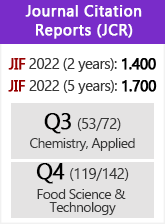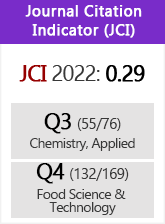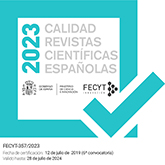Instrumental methods for NaCl analysis in olive brines
DOI:
https://doi.org/10.3989/gya.1991.v42.i4.1230Keywords:
Brine, Flame photometric, ion-selective electrode, Method (comparison), Sodium chloride (determination), Volhard methodAbstract
Aplicability of flame photometric and ion selective (sodium or chloride) methods to determinate NaCI concentration in olive brines in comparison with the official one (Volhard), which uses AgNO3, is studied. According to the results using standard solutions or fermentative olive brines without previous lye treatment, no proportional systematic or constant systematic errors are detected and the percentaje of NaCl is evaluated by them with the same accuracy as by the reference. However, when the flame photometric or sodium ion-selective methods are used to determine this compound in Spanish olive brines, there is a deviation in comparison with the values obtained by the official one (Volhard) that is correlated with the combine acidity concentration of the solution. This fact is due to the presence of sodium organic salts, called combined acidity, that are formed during the lye treatment or "cocido" that these fruits are given before fermentation. Nevertheless, is does not represent any problem as there is a good correlation between such combined acidity and the magnitude of the deviation, that permit to calculate the corresponding correction factor. In addition these problems can be solved using the chloride selective ion method.
Downloads
Download data is not yet available.
Downloads
Published
1991-08-30
How to Cite
1.
García García P, Brenes Balbuena M, Garrido Fernández A. Instrumental methods for NaCl analysis in olive brines. Grasas aceites [Internet]. 1991Aug.30 [cited 2024Jul.27];42(4):261-6. Available from: https://grasasyaceites.revistas.csic.es/index.php/grasasyaceites/article/view/1230
Issue
Section
Research
License
Copyright (c) 1991 Consejo Superior de Investigaciones Científicas (CSIC)

This work is licensed under a Creative Commons Attribution 4.0 International License.
© CSIC. Manuscripts published in both the printed and online versions of this Journal are the property of Consejo Superior de Investigaciones Científicas, and quoting this source is a requirement for any partial or full reproduction.All contents of this electronic edition, except where otherwise noted, are distributed under a “Creative Commons Attribution 4.0 International” (CC BY 4.0) License. You may read here the basic information and the legal text of the license. The indication of the CC BY 4.0 License must be expressly stated in this way when necessary.
Self-archiving in repositories, personal webpages or similar, of any version other than the published by the Editor, is not allowed.
















